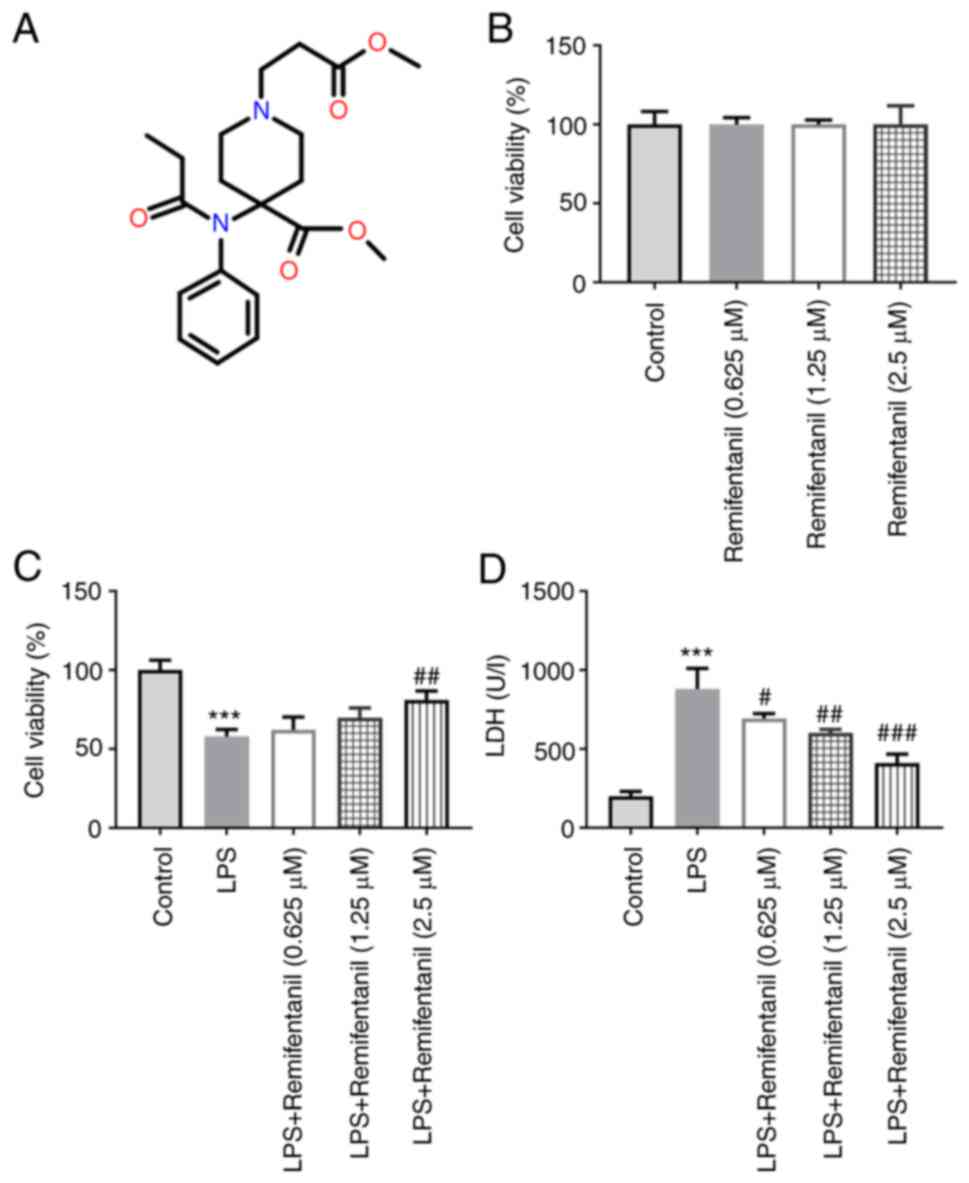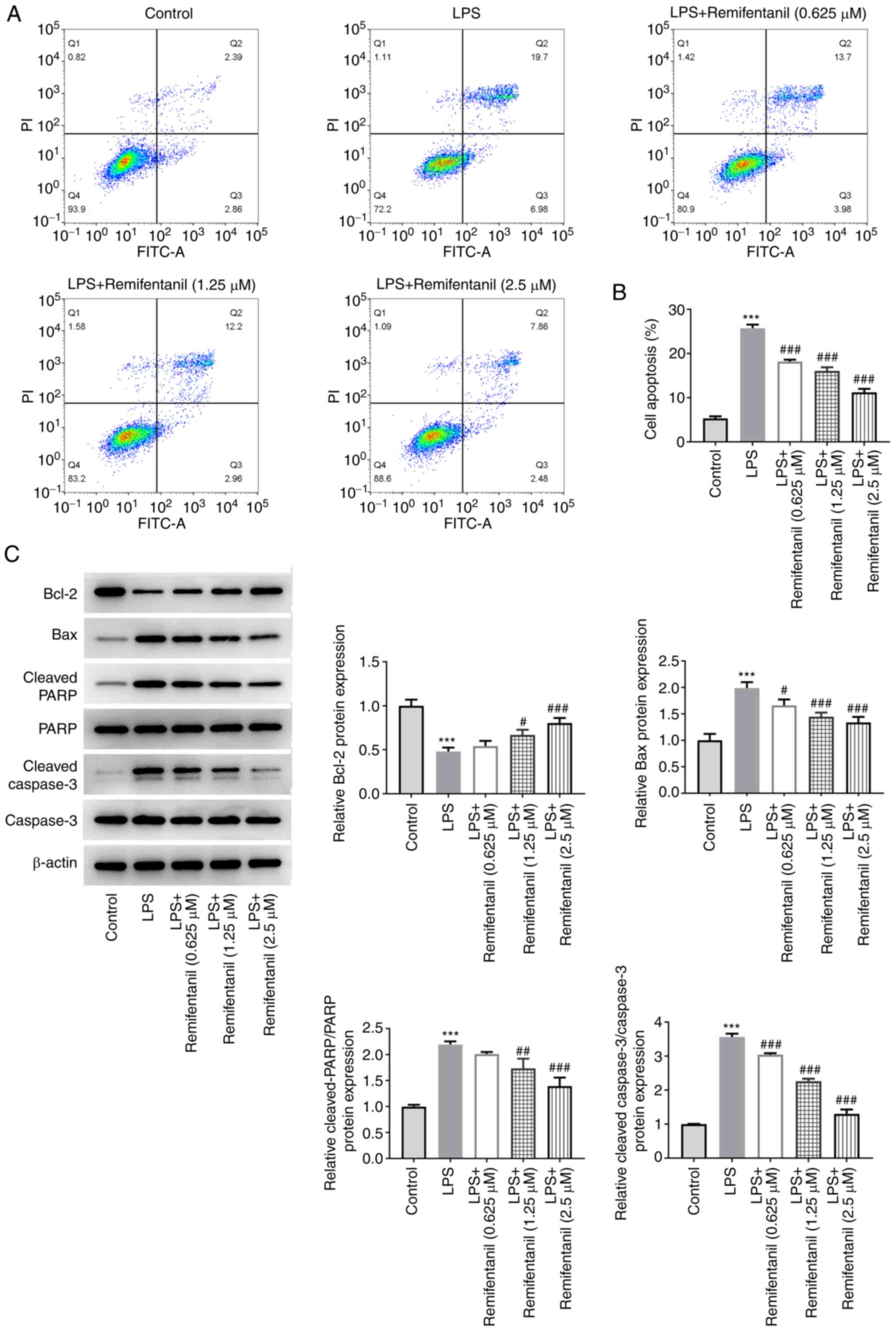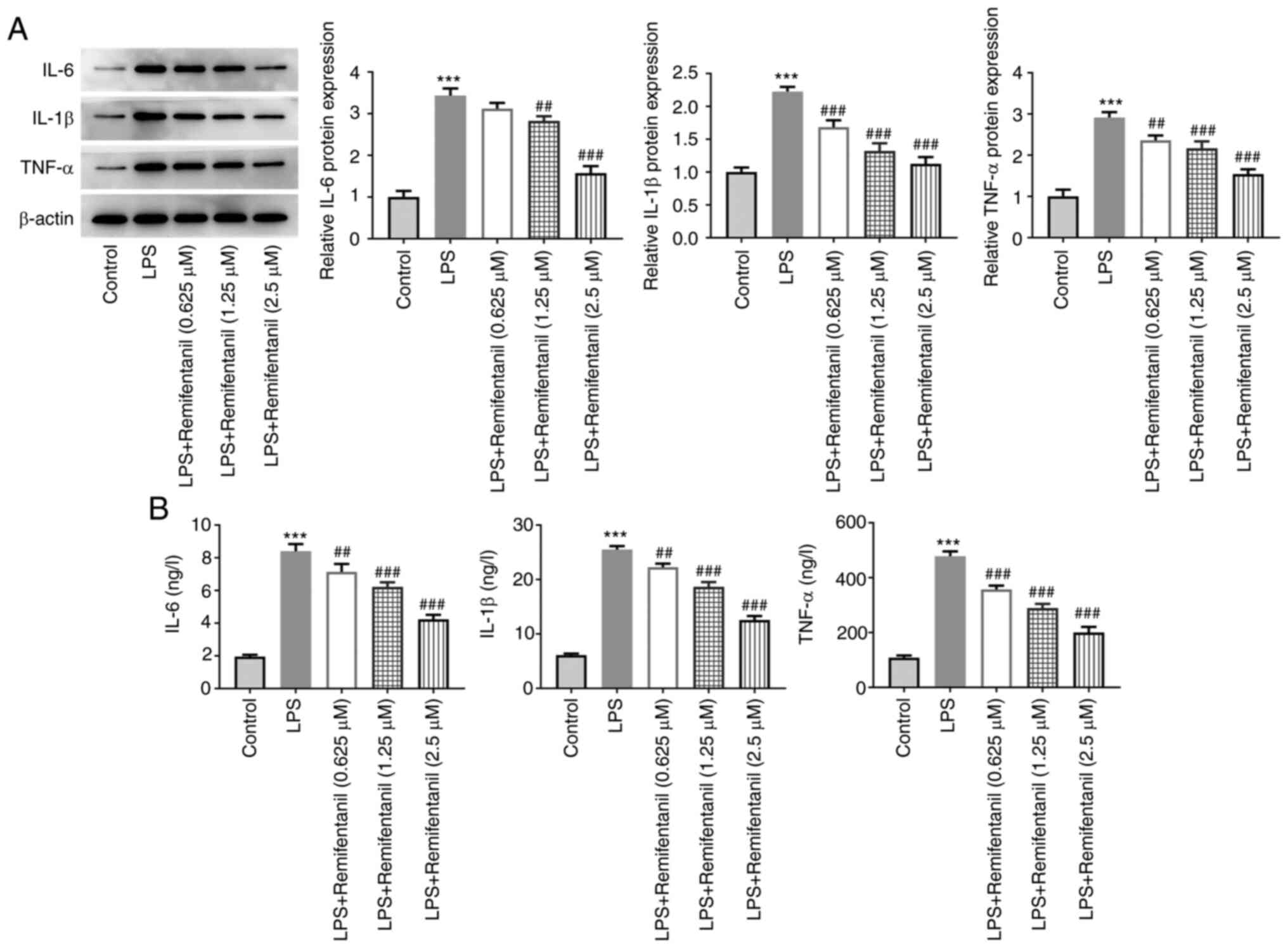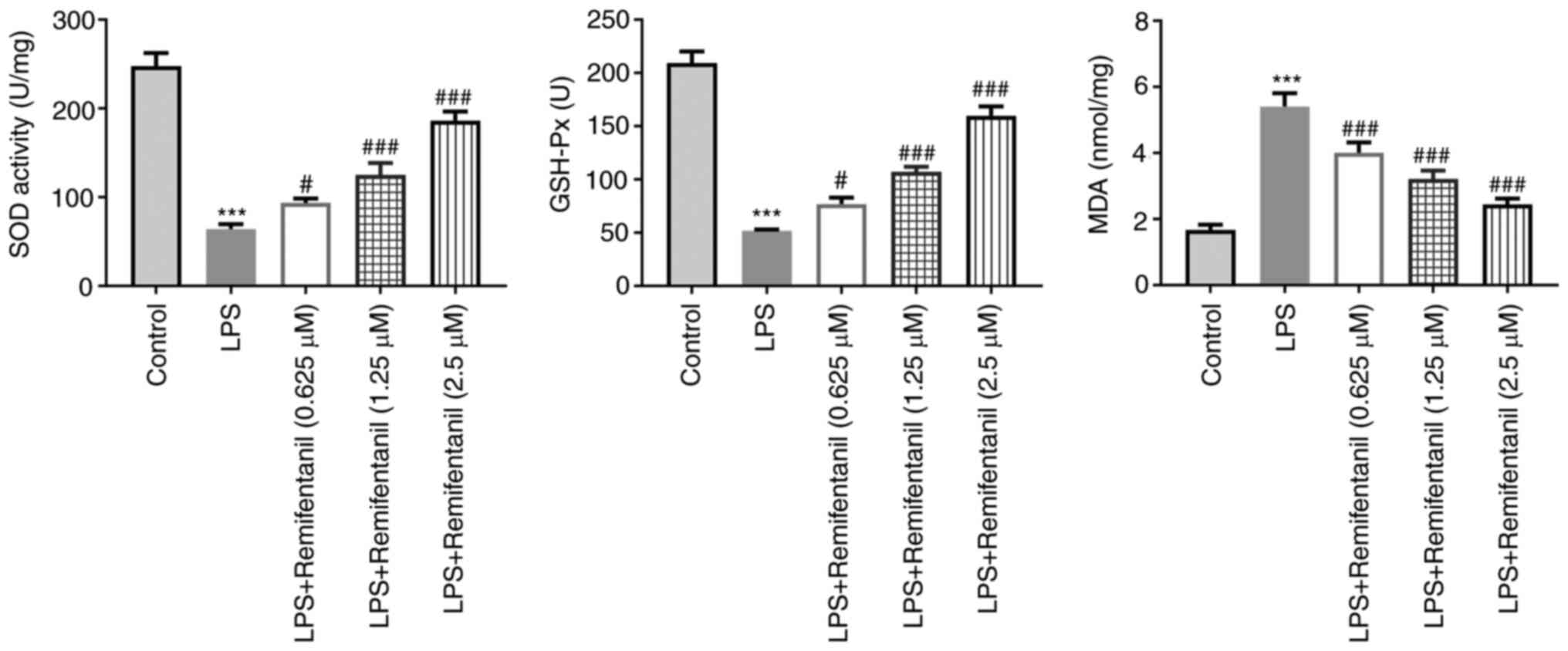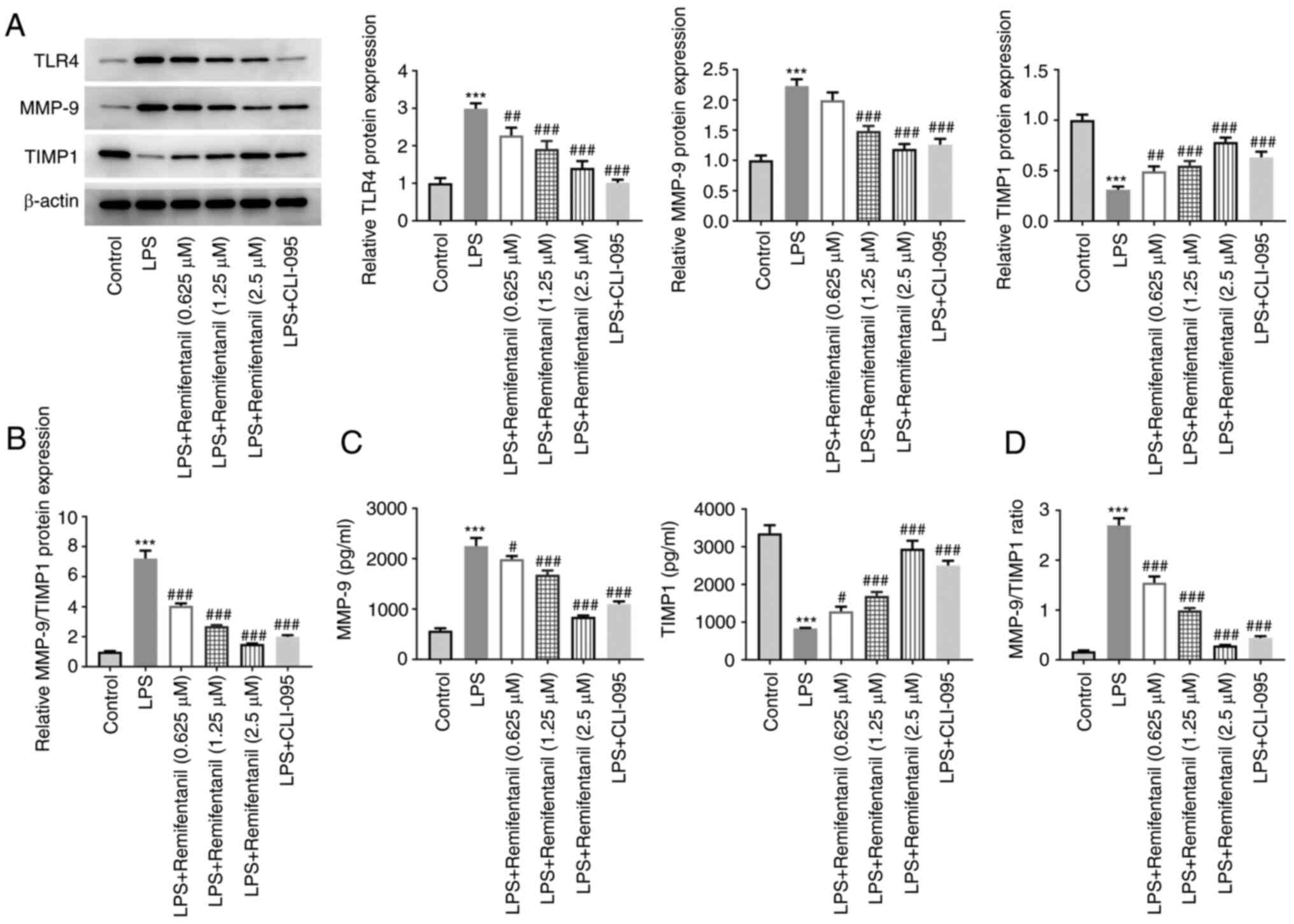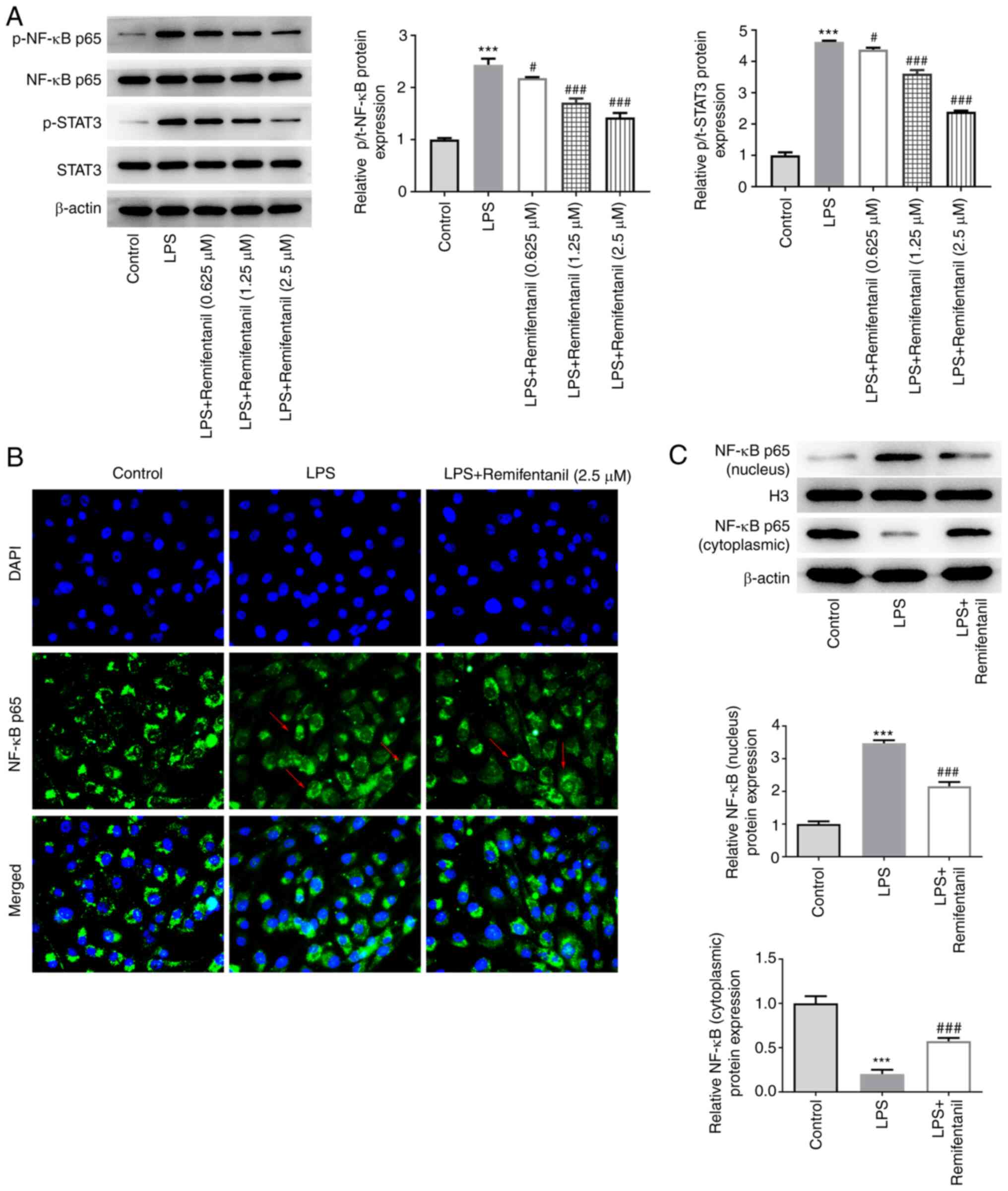Remifentanil modulates the TLR4‑mediated MMP‑9/TIMP1 balance and NF‑κB/STAT3 signaling in LPS‑induced A549 cells
- Authors:
- Published online on: December 30, 2022 https://doi.org/10.3892/etm.2022.11778
- Article Number: 79
-
Copyright: © Chang et al. This is an open access article distributed under the terms of Creative Commons Attribution License.
Abstract
Introduction
The pathology of acute lung injury (ALI) or acute respiratory distress syndrome (ARDS) is characterized by elevations in alveolar-capillary permeability caused by inflammation, trauma and burns (1). This in turn triggers atelectasis and excessive inflammatory responses, resulting in progressively worsening respiratory failure (2). In particular, sepsis is one of the main causes of ALI, which is frequently mediated indirectly by lipopolysaccharides (LPSs) released from the outer layer of the cell wall of gram-negative bacteria (3). LPS can activate inflammation by interacting with cell surface receptors including LBP, CD14, MD2 and TLR4 to promote structural damage and dysfunction in the physiological epithelial and endothelial barriers (4,5). This is facilitated following the activation of second messengers including cAMP and cGMP and related signaling pathways including NFκB signaling and the PI3K/Akt pathway (6). Although numerous studies have previously revealed that inflammatory factors including TNF-α and IL-6 can become activated during ALI (7-9), the use of anti-inflammatory drugs (such as sivelestat and simvastatin) in clinical practice was not able to effectively reduce the mortality rate which is estimated as 30-40% globally (10). To date, no effective prevention or treatment measures exist for septic ALI (11). Clinically, mechanical ventilation is the main supportive treatment strategy (12); however, the mechanical tension generated by the ventilation process itself can also cause lung injury (13). Therefore, novel treatment methods for ALI remain in demand.
Remifentanil is a synthetic piperidine derivative and a selective opioid receptor agonist (14). Remifentanil has high affinity for µ-opioid receptors but weaker affinity for δ and κ receptors (15). Its analgesic effect has been reported to be 250 times that of morphine (16). The pharmacokinetics of remifentanil are characterized by a rapid onset of action followed by rapid clearance (17). Since its clearance is mainly dependent on non-specific esterase degradation in the plasma or tissue, it is not affected by liver and kidney function, sex, age and body weight; Remifentanil has a short half-life and high plasma clearance rate, and is the first choice for special populations (over 65 years old, liver and kidney insufficiency, children or obesity) (18). In addition, there were no alterations in its metabolic rate or accumulation in the body after long-term infusion or repeated injections (19). Owing to these aforementioned advantages, remifentanil is used extensively as a general anesthesia (20). Previous studies have reported that remifentanil pre-treatment can alleviate myocardial ischemia/reperfusion injury, the mechanism of which is associated with the inhibition of oxidative stress and apoptosis (21,22). Remifentanil can also inhibit the LPS-induced inflammatory response in human aortic endothelial cells through the poly (ADP-ribose) polymerase 1 (PARP-1)/NF-κB signaling pathway (23). Furthermore, remifentanil has been found to inhibit the expression and release of high mobility group box protein 1 in the liver, lungs, and kidney tissues of septic rats (24). TLR4 is a member of TLRs family, regulating inflammatory response (25). Increased expression of MMP9 and increased ratio of MMP-9/tissue inhibitors of metalloproteinase 1 (TIMP1) expression are considered to be primary indicators of chronic airway injury and emphysema (26). Notably, TLR4 has been reported to regulate hippocampal MMP/TIMP imbalance in perioperative neurocognitive disorder in diabetes (27). Therefore, remifentanil treatment may exert regulatory effects on TLR4-mediated MMP-9/TIMP1 balance and inhibit inflammatory injury in lung epithelial cells.
A549 lung adenocarcinoma cells have been extensively used as a cell model for type II pulmonary epithelial cells (28,29). Therefore, in the present study, A459 cells were selected and LPS was used as the treatment to establish inflammatory damage models. The aim of the present study was to investigate the effects of remifentanil on inflammatory injury in the cells, the MMP-9/TIMP1 balance and possible regulatory pathways.
Material and methods
Cell culture
A549 lung adenocarcinoma cells (Procell Life Science & Technology Co., Ltd.) were cultured in the DMEM (Gibco; Thermo Fisher Scientific, Inc.) supplemented with 10% FBS (Gibco; Thermo Fisher Scientific, Inc.) in a humidified chamber at 37˚C with 5% CO2. Remifentanil was obtained from Jiangsu Nhwa Pharmaceutical Co., Ltd. (Xuzhou, China), with the concentrations (0.625, 1.25 and 2.5 µM) set at 37˚C according to previous studies (23,30). LPS (10 µg/ml; Beyotime Institute of Biotechnology) was used to treat the cells at 37˚C for 24 h (31). The TLR4 inhibitor CLI-095 (also known as resatorvid; 3 µM; Selleck Chemicals) was added at 37˚C for 6 h to suppress TLR4 signaling (32). Cells in the treatment group were treated with remifentanil for 30 min prior to LPS stimulation. Untreated cells were regarded to be the control group.
Cell Counting Kit-8 (CCK-8) assay
A549 cells were seeded into 96-well plates at a density of 5x103 cells/well (100 µl) and treated with remifentanil or LPS, as aforementioned. Following 24 h of incubation, 10 µl CCK-8 reagent (AmyJet Scientific, Inc.) was added to each well before the cells were incubated at 37˚C for a 1 h. The optical density in each well was measured using a microplate reader (450 nm; Nanjing Detie Laboratory Equipment Co., Ltd.).
Lactate dehydrogenase (LDH) release assay
A549 cells (5x103 cells/well; 150 µl) were treated with remifentanil and LPS at 37˚C, as aforementioned. At 23 h incubation, the LDH release reagent (15 µl) provided by the LDH Cytotoxicity Assay Kit (cat. no. C0016; Beyotime Institute of Biotechnology) was added to the wells, and the cells were incubated for 1 h (24 h total incubation). The cells were then centrifuged at 400 x g for 5 min at room temperature before 120 µl supernatant was taken from each well for measurement. LDH release was measured by plotting a standard curve after OD values were obtained using a microplate reader (490 nm).
Flow cytometry
Apoptosis was analyzed by flow cytometry using an Annexin V-FITC Apoptosis Detection Kit (cat. no. C1062; Beyotime Institute of Biotechnology). Briefly, treated or untreated A549 cells (1x105), aforementioned, were washed twice with pre-cooled PBS and suspended in 195 µl binding buffer. The cell suspension (5x105 cells/ml) was then transferred into a tube and incubated with Annexin V-FITC (5 µl) and propidium iodide (10 µl) at room temperature in the dark for 15 min. Results were obtained using a BD FACSCanto II flow cytometer (BD Biosciences) and FlowJo version 10 software (FlowJo LLC).
Western blotting
Protein extracts of A549 cells were obtained using the RIPA lysis buffer (Beijing Solarbio Science & Technology Co., Ltd.), cytoplasmic and nuclear protein were extracted using NE-PER Nuclear and Cytoplasmic Extraction Reagents (Pierce; Thermo Fisher Scientific, Inc.), according to the manufacturer's protocol and protein concentrations were determined using the BCA assay kit (Pierce; Thermo Fisher Scientific, Inc.). Protein samples (30 µg/lane) were subjected to SDS-PAGE (10%) and transferred onto PVDF membranes (MilliporeSigma). Following blocking in 5% non-fat milk for 1 h at room temperature, the membranes were incubated with the indicated primary antibodies at 4˚C overnight and then with the respective HRP-conjugated secondary antibodies at room temperature for 2 h; all antibodies used in the present study are listed in Table I. Protein bands were visualized using an DBI TOP-ECL chemiluminescence reagent (Shanghai Xinghan Biotechnology Co., Ltd.) and quantified using ImageJ software (version 1.52v; National Institutes of Health).
ELISA
ELISA kits were used to measure the levels of inflammatory factors, including IL-6 (cat. no. ZN2272), IL-1β (cat. no. ZN2236) and TNF-α (cat. no. ZN2460; Beijing Biolab Technology Co., Ltd.), as well as the secretion levels MMP9 (cat. no. BMS2016-2; Invitrogen; Thermo Fisher Scientific, Inc.) and TIMP1 (cat. no. PT888; Beyotime Institute of Biotechnology). The operating steps were performed according to the respective protocols. Briefly, cell culture media (500 µl) from A549 cells treated with remifentanil and LPS following 18 h of incubation at room temperature was centrifuged at 2,000 x g for 10 min at room temperature to remove debris before the supernatant was collected for assaying. The samples (100 µl) were then incubated at room temperature with (in order): Biotin-labeled antibodies (100 µl) for 1 h, avidin-peroxidase complex (100 µl) for 25 min, TMB chromogenic solution (100 µl) for 20 min and stop solution (50 µl). Protein levels were measured by plotting a standard curve after the OD values were obtained using a microplate reader (450 nm).
Oxidative stress assessment
Superoxide dismutase (SOD; cat. no. A001-1), glutathione peroxidase (GSH; cat. no. A005-1) and malondialdehyde (MDA; cat. no. A003-4-1; Nanjing Jiancheng Bioengineering Institute) assay kits were used to assess their levels. Briefly, following indicated treatment, supernatant of A549 cells (1x106) were collected using centrifugation at 1,000 x g for 5 min at 4˚C and 10-50 µl of supernatant was used to analyze the levels of oxidative stress according to the manufacturer's protocol of corresponding kits. The OD values at 450 nm were measured using a microplate reader.
Immunofluorescence (IF)
IF was performed to verify the localization of NF-κB p65. Briefly, treated or untreated A549 cells (5x104 cells/well) plated in a 24-well plate for 24 h were fixed with 4% paraformaldehyde at room temperature for 15 min and permeabilized with 0.5% Triton X-100 at room temperature for 15 min. The cells were then blocked with 10% goat serum (Beijing Solarbio Science & Technology Co., Ltd.) for 1 h at room temperature, incubated with the NF-κB p65 primary antibody (1:100) overnight at 4˚C and FITC-conjugated goat anti-rabbit secondary antibodies (1:1,000; cat. no. orb688925; Biorbyt, Ltd.) for 1 h at room temperature in the dark. The nuclei were stained with DAPI (5 µg/ml) for 5 min at room temperature, and the immunostaining was examined under a fluorescence microscope (Leica Microsystems GmbH) at x200 magnification.
Statistical analysis
All experiments were performed at least three times, and normally distributed data were expressed as the mean ± standard deviation. The data were analyzed by one-way ANOVA followed by Tukey's post hoc test using the SPSS version 13 software (SPSS, Inc.). P<0.05 was considered to indicate a statistically significant difference.
Results
Remifentanil improves the viability in LPS-treated cells
The chemical structure of remifentanil is displayed in Fig. 1A. The effects of different concentrations of remifentanil on A549 cell viability was determined using CCK-8 assay (Fig. 1B); the highest remifentanil concentration tested (2.5 µM) did not affect cell viability, suggesting it is a safe cell treatment concentration. The viability of cells treated with LPS was decreased significantly compared with untreated cells (Fig. 1C), whereas the viability of cells co-treated with remifentanil at a concentration of 2.5 µM was markedly increased compared with that in the LPS-only group. In addition, the level of LDH release in each treatment group of cells was measured. The results revealed that the degree of LDH release by cells in the LPS-only group was significantly higher compared with that in the control group (Fig. 1D). The LDH levels in cells co-treated with remifentanil were significantly reduced compared with that in the LPS group.
Remifentanil suppresses LPS-induced apoptosis
To evaluate the effect of remifentanil on apoptosis, the apoptotic rates of cells in each treatment group were detected by flow cytometry. The proportion of early-(Q3) and late-stage (Q2) apoptotic cells in the LPS group was significantly increased compared with that in the control group (Fig. 2A and B). Compared with that in the LPS-only group, the proportion of apoptotic cells in the remifentanil co-treated groups was all significantly decreased. In addition, the expression levels of apoptosis-related proteins were measured using western blotting (Fig. 2C). Compared with the control group, the protein expression levels of Bax, cleaved PARP and cleaved caspase 3 in the LPS group were significantly increased, whereas those of the Bcl-2 protein were significantly decreased. By contrast, remifentanil co-treatment reversed the alterations in the protein expression levels, with the differences reaching significance at higher concentrations tested. These data suggested that remifentanil may alleviate LPS-induced apoptosis.
Remifentanil reduces inflammation and oxidative stress caused by LPS
Inflammation-related cytokine levels were determined using western blotting and ELISA (Fig. 3A and B, respectively). The levels of IL-6, IL-1β and TNF-α expression and secretion were significantly elevated in the LPS-only group compared with the untreated control group, and these were reversed by remifentanil co-treatment in a concentration-dependent manner.
The levels of oxidative stress markers were also measured using their corresponding assay kits. The levels of SOD and GSH-Px were significantly reduced in the LPS group compared with the control group whereas those of MDA were increased (Fig. 4). Co-treatment with remifentanil significantly reversed the aforementioned LPS-induced effects (Fig. 4). These observations suggested that remifentanil treatment may reduce oxidative stress in the cells caused by LPS.
Remifentanil modulates TLR4 to mediate MMP-9/TIMP1 imbalance in LPS-treated cells
The expression levels of TLR4, MMP-9 and TIMP1 were evaluated using western blotting (Fig. 5A and B). The expression levels of TLR4 and MMP-9 were significantly elevated in the LPS-treated group, whilst those of TIMP1 were decreased. MMP-9/TIMP1 ratio significantly elevated upon LPS treatment. By contrast, remifentanil co-treatment significantly reversed the LPS-induced increase in TLR4 and MMP-9 expressions and the decreased TIMP1 expression. To further assess the role of TLR4 in the MMP-9/TIMP1 expression balance, the cells were treated with the TLR4 inhibitor, CLI-095. Compared with those in the LPS group, CLI-095 co-treatment significantly reduced the expression of TLR4. Moreover, relative to LPS group, additional CLI-095 treatment weakened MMP-9 expression and content, whilst increasing those of TIMP1, resulting in a decrease in MMP-9/TIMP1 ratio. The effect of CLI-095 on the secretion of MMP-9 and TIMP1 was similar to that induced by LPS + 2.5 µM remifentanil group (Fig. 5C and D). These data suggested that remifentanil may restore MMP-9/TIMP1 imbalance to the normal level in LPS-treated cells via mediatingTLR4 signaling.
Remifentanil regulates the NF-κB/STAT3 signaling pathway
The expression levels of proteins in the NF-κB/STAT3 signaling pathway were assessed using western blotting. The phosphorylation levels of NF-κB and STAT3 proteins were found to be significantly elevated in the LPS group compared with the control, and these were significantly reversed by remifentanil co-treatment (Fig. 6A). To verify whether NF-κB signaling was activated or blocked, nuclear translocation of NF-κB p65 was examined using IF assay (Fig. 6B). The fluorescence of NF-κB p65 in the nucleus appeared to be enhanced in the LPS-treated group compared with the control group, and remifentanil co-treatment appeared to be lower compared with the LPS-only group, suggesting that remifentanil suppressed the nuclear translocation of NF-κB p65. However, the difference in the IF images was not obvious, so western blotting was performed. According to the western blotting data, the protein expression level of NF-κB p65 in the nucleus was significantly increased following LPS stimulation, which was accompanied by its reduction in the cytoplasm (Fig. 6C). After remifentanil co-treatment, the protein expression level of NF-κB p65 decreased in the nucleus and increased in the cytoplasm compared with that in the LPS-only group (Fig. 6C).
Discussion
Previous studies reported that aberrant coagulation, fibrinolysis and extravascular fibrosis form the key features of ALI (33-35). Among them, coagulation and fibrinolysis are closely associated with the inflammatory response and together promote ALI progression (36). When ALI occurs, endogenous endotoxemia is induced through a multitude of mechanisms, such as stress and the immune response, which stimulates the release of inflammatory mediators IL-1β and IL-6 to enhance the inflammatory response and aggravate lung dysfunction (37,38). By contrast, fibrous deposits activate endothelial cells to also produce proinflammatory cytokines including TNF-α, IL-1 and IL-6 to induce activated neutrophil aggregation (39). Persistent protein deposition can also cause vascular wall thickening, pulmonary artery thrombosis and increased risk of mortality (34). These previous findings suggest that the inflammatory response is an important cause of ALI, where the imbalance between the systemic inflammatory response and compensatory anti-inflammatory response serves a key role in its pathogenesis, during which LDH will be released into the bloodstream (40). Therefore, from the perspective of inflammation, seeking a novel therapeutic strategy for ALI prevention and treatment would be of significance for reducing the risk of morbidity and mortality. The results of the present study suggest that remifentanil may reduce apoptosis whilst alleviating inflammation and oxidative stress in LPS-treated A549 cells. Therefore, remifentanil may serve an anti-inflammatory role in ALI.
In the present study, it was found that remifentanil reduced the expression level of TLR4 and ratio of MMP-9/TIMP1 in LPS-treated cells. TLRs belong to a class of pattern recognition receptors that can mediate the inflammatory response to pathogens by inducing proinflammatory effects (25). It has been previously revealed that TLR4 is involved in the regulation of immune defense responses and inflammatory mediators in the respiratory tract during ALI progression in an animal model (4). In addition, another previous study demonstrated that remifentanil can ameliorate hepatic ischemia-reperfusion injury by upregulating the expression of β-arrestin 2, a well-known µ-opioid receptor desensitizer (41). Since β-arrestin 2 is also a negative regulator of the TLR4-mediated inflammatory response, β-arrestin 2 may serve as a key molecule connecting the µ-opioid receptor and TLR4 pathways (41). These findings imply that remifentanil might elevate β-arrestin 2 expression to suppress TLR4-mediated inflammatory response, which was consistent with the results in the present study. Reactive oxidants and free radicals can directly obstruct cell function, causing proteases, such as MMP-9, to be released. MMP-9 serves a role in various physiological processes, including extracellular matrix degradation and lung tissue remodeling (42-44), both of which have been reported to be associated with the occurrence of various lung diseases including chronic obstructive pulmonary disease and idiopathic pulmonary fibrosis (42-44). MMP9 activity is regulated by the specific endogenous inhibitor TIMP1(45). Under the action of external stimuli, the proportion of their expression and the interaction between the two can be regulated, the dysregulation of which can result in lung pathology (45). Moreover, increased expression of MMP9 and increased ratio of MMP-9/TIMP1 expression are considered to be primary indicators of chronic airway injury and emphysema (26). Notably, TLR4 has been reported to regulate hippocampal MMP/TIMP imbalance in perioperative neurocognitive disorder in diabetes (27). Therefore, identifying the upstream pathway(s) that may alleviate the imbalance and, in turn, designing putative intervention methods is currently garnering research interest. In the present study, remifentanil was found to restore their imbalance to the normal level, indicating it has the potential to treat ALI.
As a proinflammatory factor, LPS induces the inflammatory response, mainly by activating the NF-κB pathway (6). Previous studies have shown that remifentanil can alleviate endothelial cell inflammation (23) and myocardial injury (46) through inhibiting NF-κB signaling, where activating TLR4 can lead to the activation of NF-κB signaling (47). NF-κB is one of the most important nuclear transcription factors in cells and serves a central role in the transcriptional regulation of cellular messages mediated by stimuli including inflammation and infection (48). NF-κB activation can promote the expression and release of ILs and TNF-α, which can be applied for diagnosis and severity assessment of ALI (49). Furthermore, activation of the STAT3 signaling pathway can also promote the production of inflammatory cytokines and chemokines to aggravate the process of ALI (50). Following the action of Janus kinase, STAT3 in the cytoplasm dimerizes due to following Y705 and S727 phosphorylation in its protein structure, where STAT3 can also be activated by reversible acetylation (51). Activated STAT3 will then translocate into the nucleus and bind to genomic DNA to regulate transcription (52). Previous studies have revealed that in innate immunity, adaptive immunity, acute and chronic inflammation, and tumor occurrence, STAT3 activity is aberrantly activated with high frequencies (43,53-55). STAT3 cooperates with NF-κB to drive inflammatory response (56). Therefore, the apparent suppressive effects of remifentanil on NF-κB/STAT3 signaling may be one of the mechanism by which it alleviates ALI. However, the present study is limited to in vivo experiments using A549 cells. Other cell types, such as primary cells, in addition to in vivo studies, are required.
In conclusion, the present study found that remifentanil restored MMP-9/TIMP1 imbalance to the normal level via mediating TLR4 and inhibited inflammatory injury in LPS-treated cells by regulating NF-κB/STAT3 signaling. It is hoped that these findings may facilitate the development of novel ALI treatment methods.
Acknowledgements
Not applicable.
Funding
Funding: No funding was received.
Availability of data and materials
The datasets used and/or analyzed during the current study are available from the corresponding author on reasonable request.
Authors' contributions
JC and WZ contributed to the experimental design, conducting experiments and data analysis. JC contributed to the writing of the manuscript. JC and WZ approved the final version of the manuscript and confirm the authenticity of all the raw data.
Ethics approval and consent to participate
Not applicable.
Patient consent for publication
Not applicable.
Competing interests
The authors declare that they have no competing interests.
References
|
Swenson KE and Swenson ER: Pathophysiology of acute respiratory distress syndrome and COVID-19 lung injury. Crit Care Clin. 37:749–776. 2021.PubMed/NCBI View Article : Google Scholar | |
|
Zhou Y, Li P, Goodwin AJ, Cook JA, Halushka PV, Chang E, Zingarelli B and Fan H: Exosomes from endothelial progenitor cells improve outcomes of the lipopolysaccharide-induced acute lung injury. Crit Care. 23(44)2019.PubMed/NCBI View Article : Google Scholar | |
|
Li J, Lu K, Sun F, Tan S, Zhang X, Sheng W, Hao W, Liu M, Lv W and Han W: Panaxydol attenuates ferroptosis against LPS-induced acute lung injury in mice by Keap1-Nrf2/HO-1 pathway. J Transl Med. 19(96)2021.PubMed/NCBI View Article : Google Scholar | |
|
Wang YM, Ji R, Chen WW, Huang SW, Zheng YJ, Yang ZT, Qu HP, Chen H, Mao EQ, Chen Y and Chen EZ: Paclitaxel alleviated sepsis-induced acute lung injury by activating MUC1 and suppressing TLR-4/NF-κB pathway. Drug Des Devel Ther. 13:3391–3404. 2019.PubMed/NCBI View Article : Google Scholar | |
|
Cheng KT, Xiong S, Ye Z, Hong Z, Di A, Tsang KM, Gao X, An S, Mittal M, Vogel SM, et al: Caspase-11-mediated endothelial pyroptosis underlies endotoxemia-induced lung injury. J Clin Invest. 127:4124–4135. 2017.PubMed/NCBI View Article : Google Scholar | |
|
Tang J, Xu L, Zeng Y and Gong F: Effect of gut microbiota on LPS-induced acute lung injury by regulating the TLR4/NF-kB signaling pathway. Int Immunopharmacol. 91(107272)2021.PubMed/NCBI View Article : Google Scholar | |
|
McVey MJ, Steinberg BE and Goldenberg NM: Inflammasome activation in acute lung injury. Am J Physiol Lung Cell Mol Physiol. 320:L165–L178. 2021.PubMed/NCBI View Article : Google Scholar | |
|
Gouda MM and Bhandary YP: Acute lung injury: IL-17A-mediated inflammatory pathway and its regulation by curcumin. Inflammation. 42:1160–1169. 2019.PubMed/NCBI View Article : Google Scholar | |
|
Chen C, He Y, Feng Y, Hong W, Luo G and Ye Z: . Long non-coding RNA review and implications in acute lung inflammation. Life Sci. 269(119044)2021.PubMed/NCBI View Article : Google Scholar | |
|
Chen T, Wei Y, Zhu G, Zhao H and Zhang X: Design, synthesis and structure-activity relationship studies of 4-indole-2-arylaminopyrimidine derivatives as anti-inflammatory agents for acute lung injury. Eur J Med Chem. 225(113766)2021.PubMed/NCBI View Article : Google Scholar | |
|
Song W, Yang X, Wang W, Wang Z, Wu J and Huang F: Sinomenine ameliorates septic acute lung injury in mice by modulating gut homeostasis via aryl hydrocarbon receptor/Nrf2 pathway. Eur J Pharmacol. 912(174581)2021.PubMed/NCBI View Article : Google Scholar | |
|
Brochard L, Slutsky A and Pesenti A: Mechanical ventilation to minimize progression of lung injury in acute respiratory failure. Am J Respir Crit Care Med. 195:438–442. 2017.PubMed/NCBI View Article : Google Scholar | |
|
Beitler JR, Malhotra A and Thompson BT: Ventilator-induced lung injury. Clin Chest Med. 37:633–646. 2016.PubMed/NCBI View Article : Google Scholar | |
|
Cappoli N, Aceto P, Tabolacci E, Mezzogori D, Sollazzi L, Navarra P and Dello Russo C: Effects of remifentanil on human C20 microglial pro-inflammatory activation. Eur Rev Med Pharmacol Sci. 25:5268–5274. 2021.PubMed/NCBI View Article : Google Scholar | |
|
Nowoczyn M, Marie N, Coulbault L, Hervault M, Davis A, Hanouz JL and Allouche S: Remifentanil produces cross-desensitization and tolerance with morphine on the mu-opioid receptor. Neuropharmacology. 73:368–379. 2013.PubMed/NCBI View Article : Google Scholar | |
|
Azzam AAH, McDonald J and Lambert DG: Hot topics in opioid pharmacology: Mixed and biased opioids. Br J Anaesth. 122:e136–e145. 2019.PubMed/NCBI View Article : Google Scholar | |
|
Grillot N, Garot M, Lasocki S, Huet O, Bouzat P, Le Moal C, Oudot M, Chatel-Josse N, El Amine Y, Danguy des Déserts M, et al: Assessment of remifentanil for rapid sequence induction and intubation in patients at risk of pulmonary aspiration of gastric contents compared to rapid-onset paralytic agents: Study protocol for a non-inferiority simple blind randomized controlled trial (the REMICRUSH study). Trials. 22(237)2021.PubMed/NCBI View Article : Google Scholar | |
|
Kato M, Satoh D, Okada Y, Sugiyama K, Toda N and Kurosawa S: Pharmacodynamics and pharmacokinetics of remifentanil: Overview and comparison with other opioids. Masui. 56:1281–1286. 2007.PubMed/NCBI(In Japanese). | |
|
Bevans T, Deering-Rice C, Stockmann C, Light A, Reilly C and Sakata DJ: Inhaled remifentanil in rodents. Anesth Analg. 122:1831–1838. 2016.PubMed/NCBI View Article : Google Scholar | |
|
Grape S, Kirkham KR, Frauenknecht J and Albrecht E: Intra-operative analgesia with remifentanil vs dexmedetomidine: A systematic review and meta-analysis with trial sequential analysis. Anaesthesia. 74:793–800. 2019.PubMed/NCBI View Article : Google Scholar | |
|
Ni XQ and Hu ZY: Remifentanil improves myocardial ischemia-reperfusion injury in rats through inhibiting IL-18 signaling pathway. Eur Rev Med Pharmacol Sci. 24:3915–3922. 2020.PubMed/NCBI View Article : Google Scholar | |
|
Cao D, Liu S, Yang M, Xie K, Zheng Z, Wen H and Xie X: Remifentanil preconditioning alleviates myocardial ischemia/reperfusion injury in rats via activating Jagged-1/Notch signaling pathway. Biosci Rep: BSR20210534, 2021 (Epub ahead of print). | |
|
Zhang JN, Ma Y, Wei XY, Liu KY, Wang H, Han H, Cui Y, Zhang MX and Qin WD: Remifentanil protects against lipopolysaccharide-induced inflammation through PARP-1/NF-κB signaling pathway. Mediators Inflamm. 2019(3013716)2019.PubMed/NCBI View Article : Google Scholar | |
|
Seo KH, Choi JW, Jung HS, Yoo H and Joo JD: The effects of remifentanil on expression of high mobility group box 1 in septic rats. J Korean Med Sci. 32:542–551. 2017.PubMed/NCBI View Article : Google Scholar | |
|
Tall AR and Yvan-Charvet L: Cholesterol, inflammation and innate immunity. Nat Rev Immunol. 15:104–116. 2015.PubMed/NCBI View Article : Google Scholar | |
|
Chung FT, Huang HY, Lo CY, Huang YC, Lin CW, He CC, He JR, Sheng TF and Wang CH: Increased ratio of matrix metalloproteinase-9 (MMP-9)/tissue inhibitor metalloproteinase-1 from alveolar macrophages in chronic asthma with a fast decline in FEV(1) at 5-year follow-up. J Clin Med. 8(1451)2019.PubMed/NCBI View Article : Google Scholar | |
|
Zhang Y, Liu H, Chen Z, Yu M, Li J, Dong H, Li N, Ding X, Ge Y, Liu C, et al: TLR4-mediated hippocampal MMP/TIMP imbalance contributes to the aggravation of perioperative neurocognitive disorder in db/db mice. Neurochem Int. 140(104818)2020.PubMed/NCBI View Article : Google Scholar | |
|
Zhang C, Zhu X, Hua Y, Zhao Q, Wang K, Zhen L, Wang G, Lü J, Luo A, Cho WC, et al: YY1 mediates TGF-β1-induced EMT and pro-fibrogenesis in alveolar epithelial cells. Respir Res. 20(249)2019.PubMed/NCBI View Article : Google Scholar | |
|
Foster KA, Oster CG, Mayer MM, Avery ML and Audus KL: Characterization of the A549 cell line as a type II pulmonary epithelial cell model for drug metabolism. Exp Cell Res. 243:359–366. 1998.PubMed/NCBI View Article : Google Scholar | |
|
Lei S, Zhang Y, Su W, Zhou L, Xu J and Xia ZY: Remifentanil attenuates lipopolysaccharide-induced oxidative injury by downregulating PKCβ2 activation and inhibiting autophagy in H9C2 cardiomyocytes. Life Sci. 213:109–115. 2018.PubMed/NCBI View Article : Google Scholar | |
|
Xu B, Wang H and Chen Z: Puerarin inhibits ferroptosis and inflammation of lung injury caused by sepsis in LPS induced lung epithelial cells. Front Pediatr. 9(706327)2021.PubMed/NCBI View Article : Google Scholar | |
|
Zhang M, Xue Y, Chen H, Meng L, Chen B, Gong H, Zhao Y and Qi R: Resveratrol inhibits MMP3 and MMP9 expression and secretion by suppressing TLR4/NF-κB/STAT3 activation in Ox-LDL-treated HUVECs. Oxid Med Cell Longev. 2019(9013169)2019.PubMed/NCBI View Article : Google Scholar | |
|
Abedi F, Hayes AW, Reiter R and Karimi G: Acute lung injury: The therapeutic role of Rho kinase inhibitors. Pharmacol Res. 155(104736)2020.PubMed/NCBI View Article : Google Scholar | |
|
White CW, Rancourt RC and Veress LA: Sulfur mustard inhalation: Mechanisms of injury, alteration of coagulation, and fibrinolytic therapy. Ann N Y Acad Sci. 1378:87–95. 2016.PubMed/NCBI View Article : Google Scholar | |
|
Yu Y, Jiang P, Sun P, Su N and Lin F: Pulmonary coagulation and fibrinolysis abnormalities that favor fibrin deposition in the lungs of mouse antibody-mediated transfusion-related acute lung injury. Mol Med Rep. 24(601)2021.PubMed/NCBI View Article : Google Scholar | |
|
Gouda MM, Shaikh SB and Bhandary YP: Inflammatory and fibrinolytic system in acute respiratory distress syndrome. Lung. 196:609–616. 2018.PubMed/NCBI View Article : Google Scholar | |
|
Zhang HX, Liu SJ, Tang XL, Duan GL, Ni X, Zhu XY, Liu YJ and Wang CN: H2S attenuates LPS-induced acute lung injury by reducing oxidative/nitrative stress and inflammation. Cell Physiol Biochem. 40:1603–1612. 2016.PubMed/NCBI View Article : Google Scholar | |
|
Gao M, Yu T, Liu D, Shi Y, Yang P, Zhang J, Wang J, Liu Y and Zhang X: Sepsis plasma-derived exosomal miR-1-3p induces endothelial cell dysfunction by targeting SERP1. Clin Sci (Lond). 135:347–365. 2021.PubMed/NCBI View Article : Google Scholar | |
|
Ojima M, Yamamoto N, Hirose T, Hamaguchi S, Tasaki O, Kojima T, Tomono K, Ogura H and Shimazu T: Serial change of neutrophil extracellular traps in tracheal aspirate of patients with acute respiratory distress syndrome: Report of three cases. J Intensive Care. 8(25)2020.PubMed/NCBI View Article : Google Scholar | |
|
Liu Y, Yang Y, Zhang C, Huang F, Wang F, Yuan J, Wang Z, Li J, Li J, Feng C, et al: Clinical and biochemical indexes from 2019-nCoV infected patients linked to viral loads and lung injury. Sci China Life Sci. 63:364–374. 2020.PubMed/NCBI View Article : Google Scholar | |
|
Yang Y, Chen C, Cui C, Jiao Y, Li P, Zhu L, Yu W, Xia Q, Wen D and Yang L: Indispensable role of β-arrestin2 in the protection of remifentanil preconditioning against hepatic ischemic reperfusion injury. Sci Rep. 9(2087)2019.PubMed/NCBI View Article : Google Scholar | |
|
Tao Z, Jie Y, Mingru Z, Changping G, Fan Y, Haifeng W and Yuelan W: The Elk1/MMP-9 axis regulates E-cadherin and occludin in ventilator-induced lung injury. Respir Res. 22(233)2021.PubMed/NCBI View Article : Google Scholar | |
|
Liang Y, Yang N, Pan G, Jin B, Wang S and Ji W: Elevated IL-33 promotes expression of MMP2 and MMP9 via activating STAT3 in alveolar macrophages during LPS-induced acute lung injury. Cell Mol Biol Lett. 23(52)2018.PubMed/NCBI View Article : Google Scholar | |
|
Corbel M, Boichot E and Lagente V: Role of gelatinases MMP-2 and MMP-9 in tissue remodeling following acute lung injury. Braz J Med Biol Res. 33:749–754. 2000.PubMed/NCBI View Article : Google Scholar | |
|
Chen G, Ge D, Zhu B, Shi H and Ma Q: Upregulation of matrix metalloproteinase 9 (MMP9)/tissue inhibitor of metalloproteinase 1 (TIMP1) and MMP2/TIMP2 ratios may be involved in lipopolysaccharide-induced acute lung injury. J Int Med Res. 48(300060520919592)2020.PubMed/NCBI View Article : Google Scholar | |
|
Zhou Q, Song J, Wang Y and Lin T: Remifentanil attenuates cardiac dysfunction, lipid peroxidation and immune disorder in rats with isoproterenol-induced myocardial injury via JNK/NF-KB p65 inhibition. Ann Transl Med. 8(551)2020.PubMed/NCBI View Article : Google Scholar | |
|
Min Y, Kim MJ, Lee S, Chun E and Lee KY: Inhibition of TRAF6 ubiquitin-ligase activity by PRDX1 leads to inhibition of NFKB activation and autophagy activation. Autophagy. 14:1347–1358. 2018.PubMed/NCBI View Article : Google Scholar | |
|
Bianco C, Thompson L and Mohr I: Repression of eEF2K transcription by NF-κB tunes translation elongation to inflammation and dsDNA-sensing. Proc Natl Acad Sci USA. 116:22583–22590. 2019.PubMed/NCBI View Article : Google Scholar | |
|
Yang H, Lv H, Li H, Ci X and Peng L: Oridonin protects LPS-induced acute lung injury by modulating Nrf2-mediated oxidative stress and Nrf2-independent NLRP3 and NF-κB pathways. Cell Commun Signal. 17(62)2019.PubMed/NCBI View Article : Google Scholar | |
|
Zhao J, Yu H, Liu Y, Gibson SA, Yan Z, Xu X, Gaggar A, Li PK, Li C, Wei S, et al: Protective effect of suppressing STAT3 activity in LPS-induced acute lung injury. Am J Physiol Lung Cell Mol Physiol. 311:L868–L880. 2016.PubMed/NCBI View Article : Google Scholar | |
|
Dubový P, Hradilová-Svíženská I, Klusáková I, Kokošová V, Brázda V and Joukal M: Bilateral activation of STAT3 by phosphorylation at the tyrosine-705 (Y705) and serine-727 (S727) positions and its nuclear translocation in primary sensory neurons following unilateral sciatic nerve injury. Histochem Cell Biol. 150:37–47. 2018.PubMed/NCBI View Article : Google Scholar | |
|
Peron M, Dinarello A, Meneghetti G, Martorano L, Betto RM, Facchinello N, Tesoriere A, Tiso N, Martello G and Argenton F: Y705 and S727 are required for the mitochondrial import and transcriptional activities of STAT3, and for regulation of stem cell proliferation. Development. 148(dev199477)2021.PubMed/NCBI View Article : Google Scholar | |
|
Hirano T: IL-6 in inflammation, autoimmunity and cancer. Int Immunol. 33:127–148. 2021.PubMed/NCBI View Article : Google Scholar | |
|
Wang Y, Shen Y, Wang S, Shen Q and Zhou X: The role of STAT3 in leading the crosstalk between human cancers and the immune system. Cancer Lett. 415:117–128. 2018.PubMed/NCBI View Article : Google Scholar | |
|
Zou S, Tong Q, Liu B, Huang W, Tian Y and Fu X: Targeting STAT3 in cancer immunotherapy. Mol Cancer. 19(145)2020.PubMed/NCBI View Article : Google Scholar | |
|
Fan Y, Mao R and Yang J: NF-κB and STAT3 signaling pathways collaboratively link inflammation to cancer. Protein Cell. 4:176–185. 2013.PubMed/NCBI View Article : Google Scholar |



